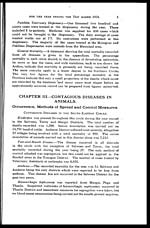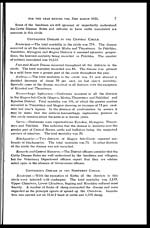Medicine - Veterinary > Civil Veterinary Departments > 1910-1941 - Annual report on the Civil Veterinary Department, Burma (including the Insein Veterinary School) > 1923-1931 > 1931
(413) Page 6
Download files
Individual page:
Thumbnail gallery: Grid view | List view

6 REPORT ON THE VETERINARY DEPARTMENT, BURMA.
It has been found difficult to diagnose this disease definitely as
Assistants will not learn to take smears from the affected part of the body.
A smear from the ear is easier to make but is useless for diagnosis. The
total mortality for the year was 84, the most severe outbreak occur-
ring in Victoria Point Subdivision, which resulted in 65 deaths. In
this outbreak protective inoculation was carried out with vaccine
procured from the Imperial Veterinary Laboratory, Muktesar.
Control Measures.—The Cattle Disease Rules are fairly well
understood and carried out in this circle and headmen and villagers are
willing to assist Departmental officers. Inoculation assisted in control-
ling the spread of rinderpest, and, in small lots of animals, also
hæmorrhagic septicæmia and anthrax.
CONTAGIOUS DISEASES IN THE SOUTH-WESTERN CIRCLE.
Rinderpest occurred in all the districts in this circle except Pyapôn.
The highest mortality was shown in Maubin District, namely 1,442.
Bassein, Henzada and Insein showed also high mortality figures. The
total number of deaths due to rinderpest for the circle was 2,804, and
the number of inoculations carried out were 14,927.
Foot-and-Mouth Disease.—All the districts were infected with foot-
and-mouth disease resulting in a total mortality of 815. Bassein and
Myaungmya Districts showed the highest figures, namely 409 and 204.
Anthrax occurred throughout all the districts of the circle. The
heaviest mortality was reported from Myaungmya (162) and Bassein
(110). The total mortality for the circle was 347.
Hæmorrhagic Septicæmia occurred in Bassein. Pyapôn and Henzada
Districts, the total mortality being 13.
Blackquarter was responsible for only three deaths during the
year in the Pyapôn and Tharrawaddy Districts.
Control Measures.—Rinderpest and foot-and-mouth disease occurred
in an epizootic form over a considerable part of the circle during the
year, and their spread is reported to be due chiefly to cattle introduced
from Upper Burma, through Prome, by trade routes. The Veterinary
Assistants have no legal power to stop movements of infected animals,
and without the co-operation of headmen it is very difficult to get cattle
drovers to carry out instructions contained in the Cattle Disease Rules.
Maubin and Insein Districts suffered a heavy mortality from rinderpest
and the chief cause in the latter district was the disinterestedness of the
Indian cattle owners to preventive measures advocated by the depart-
ment. The Cattle Disease Rules had often to be enforced with the help
of the Police.
14,927 rinderpest inoculations were carried out during the year,
and the number of deaths subsequent to inoculation was 123.
Set display mode to: Large image | Zoom image | Transcription
Images and transcriptions on this page, including medium image downloads, may be used under the Creative Commons Attribution 4.0 International Licence unless otherwise stated. ![]()
| Permanent URL | https://digital.nls.uk/75809636 |
|---|




